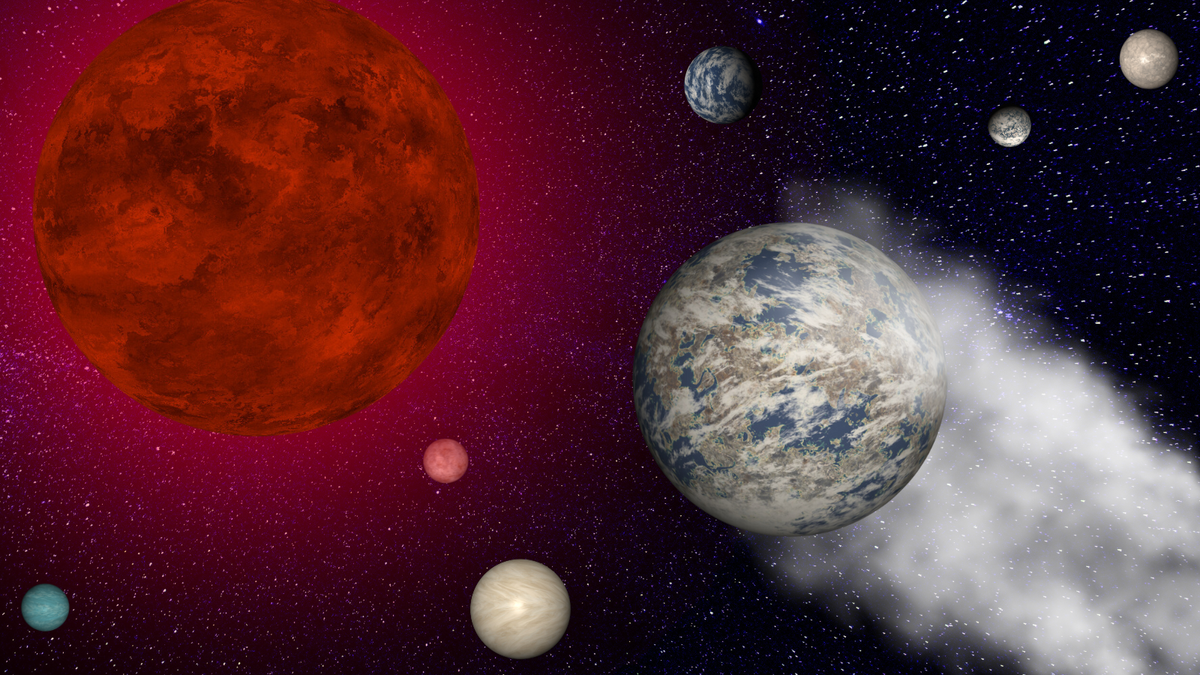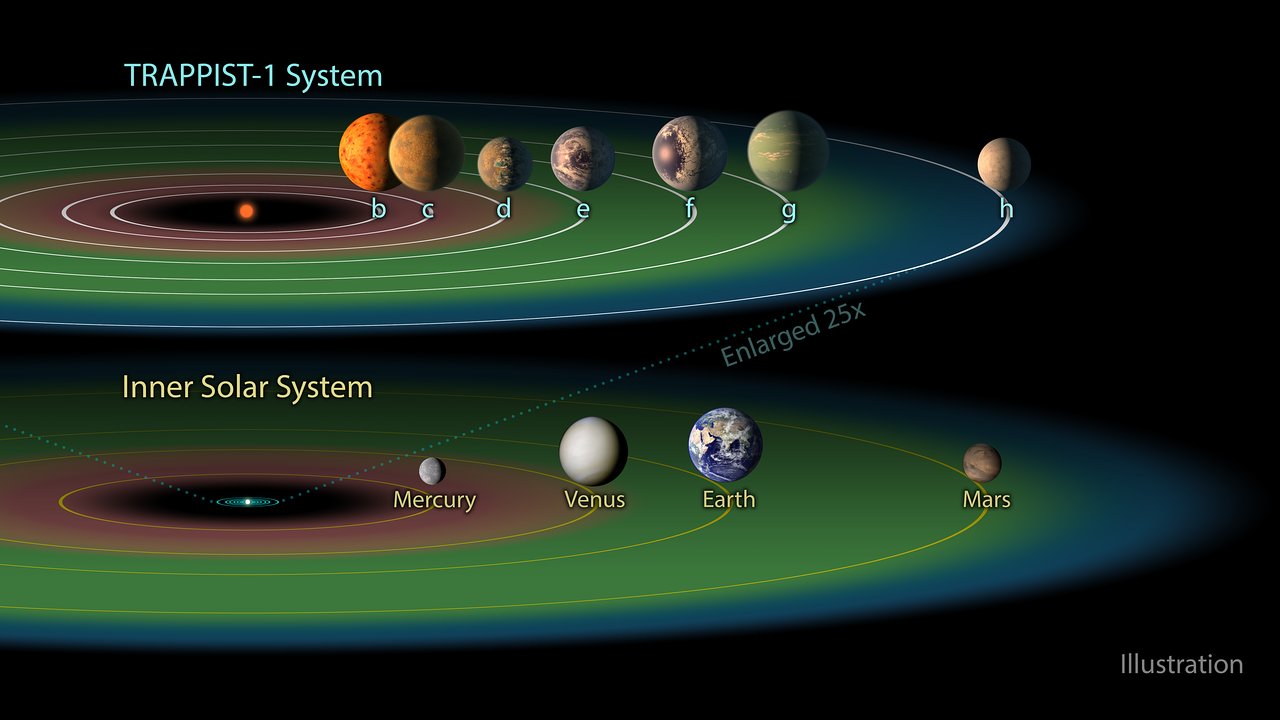
Scientists have discovered that a potentially habitable planet has had its atmosphere stripped away, a process that could eventually render the world, Trappist-1e, uninhabitable. The abstraction appears to be caused by electrical currents that arise as the planet races around its red dwarf host star.
It's an important discovery because the Trappist-1 system, in which this exoplanet orbits a small red dwarf star, has been one of the primary targets in the search for alien life. Of the seven rocky, Earth-like worlds in the system, at least three are in the habitable zone, a region around a star that is neither too hot nor too cold to allow a planet to support liquid water.
However, a planet without an atmosphere cannot hold liquid water, even if it is in the habitable zone, also known as the “Goldilocks zone.” This shows that although Trappist-1e may be in the habitable zone of the red dwarf Trappist-1, located 40 light-years from Earth, its habitability may be fleeting.
The same phenomenon affecting Trappist-1e's atmosphere could affect the atmospheres of other planets in this habitable zone as well, which is bad news for the possibility of finding life in this system.
Related: Exoplanet TRAPPIST-1 appears to have no atmosphere, and the truth may be hiding in its star, James Webb Space Telescope reveals
Methods for stripping the atmosphere of an exoplanet
Trappist-1e is roughly the size of Earth, yet has a mass of about 0.7 times the mass of our planet. It is the fourth planet from its star, and it revolves at a distance of only 0.028 times the distance between the Earth and the Sun, and it completes one revolution in only 6.1 Earth days.
Despite this proximity, because Trappist-1 is much smaller and cooler than the Sun, its habitable zone is much closer to its surface than the habitable zone of our star. To that end, it appears that it is not radiation from this red dwarf that is stripping TRAPPIST-1e's atmosphere, but rather a wind of charged particles emanating from the star called “stellar winds.”
“We looked at how space weather changes across the planet's orbit, with TRAPPIST-1e moving very quickly between very different stellar wind conditions and pressures, leading to a kind of pulsating compression and relaxation of the planet's magnetic field,” said Cecilia Garafo, of the team. A member and astrophysicist at Harvard and Smithsonian told Space.com. “This generates powerful electrical currents in the upper atmosphere – the ionosphere – that heat the atmosphere just like an electric heater.”
Earth is also experiencing changes in the solar wind, which causes a similar rise in our atmosphere, Jarrafo explained. The difference is that the heat felt by TRAPPIST-1e is up to 100,000 times stronger than the heat Earth experiences with the solar wind. This is because Trappist-1e is moving rapidly around its star, and the motion drives powerful ionospheric currents that dissipate and generate intense heat, what the team calls “voltage-directed Joule heating.”
Although the team expected this effect in 2017, the researchers were surprised by how strong they have discovered it now.
“It may be so strong for TRAPPIST-1e that the heat vaporizes the upper atmosphere,” Jarrafo said. “Over millions of years, the planet could lose its entire atmosphere due to this phenomenon.”
The team's research shows that there are more than two ways for a planet to lose its atmosphere.
Ofer Cohen, a team member and researcher at the Lowell Space Science and Technology Center, told Space.com that the loss of exoplanetary atmospheres is typically thought to be driven by some external process. These include powerful radiation from the star, which can cause the atmosphere to heat up and escape, or charged particles in the stellar wind that fling away planets, causing a powerful stripping effect.
“In this case, the warming and resulting loss of atmosphere is driven solely by the planet's rapid motion. So, the planet is dooming itself to losing its atmosphere just by moving,” Cohen said. “It's as if we're too lazy to clear the snow off the roof of our car, and we start driving, hoping that the air moving around the car will do the work for us and remove the snow — at least that's what we do in the Boston area.
“I think it's cool that planets can do that with their atmospheres.”
What about the other Trappist-1 planets?
On Earth, the magnetosphere protects our atmosphere by diverting charged particles down magnetic field lines and out of our planet. Mars, which lacks a strong magnetic field, had its atmosphere stripped away by solar winds and harsh solar radiation. In fact, the Red Planet may have lost its water to space as a result.
Trappist-1e is also thought to have a magnetosphere, but these results show that it may not be enough to prevent stripping away the atmosphere.
“Normally, a planet's magnetic field acts like a protective bubble, but around TRAPPIST-1e, that bubble is compromised,” Garaffo said. “The planet's magnetic field connects with the star's magnetic field, creating paths that allow the star's particles to hit the planet directly.” “This not only strips away the atmosphere, but also heats it significantly, making TRAPPIST-1e and its neighbors vulnerable to losing their entire atmosphere.”

Trappist-1e is the fourth planet from a red dwarf star located at the heart of this fascinating planetary system of rocky worlds. Astronomers had previously discovered that Trappist-1b, the closest exoplanet to the star, appears to have already lost its atmosphere.
The team believes that Joule heating caused by the electric potential could also affect Trappist-1f and Trappist-1g, stripping them of their atmosphere as well, although to a lesser extent than with Trappist-1e. This is because, at 0.038 and 0.04683 times the distance between Earth and the Sun from their star, respectively, these planets move more slowly through the red dwarf's stellar wind than Trappist-1e.
“Planetaries close to TRAPPIST-1 will have a more extreme fate, and planets farther away from it will have a slightly more benign fate,” Jarrafo said. “I imagine all Trappist-1 planets would have difficulty holding on to any atmosphere.”
The team's findings could have implications beyond the Trappist-1 system as well as in the search for habitable exoplanets and life outside the solar system. They point out that exoplanets close to their stars are likely to lose their atmospheres even if they are within that star's habitable zone.
The results could also help suggest which stars could host planets containing molecules that indicate the presence of life: biomarkers.
“Our research suggests that such low-mass host stars may not be the most promising for hosting planets with atmospheres,” Jarravo concluded. “Identifying host stars that could support habitable planets and monitoring those atmospheric transits using the James Webb Space Telescope and future observatories, but also building the technology to interpret those results in terms of biomarkers.”
The team's research was published on February 16 Astrophysical Journal.

“Web maven. Infuriatingly humble beer geek. Bacon fanatic. Typical creator. Music expert.”





More Stories
NASA Close to Deciding What to Do With Boeing’s Troubled Starliner Spacecraft
Scientists May Have Discovered ‘Dark Oxygen’ Created Without Photosynthesis: NPR
Real Scientists Lived on Fake Mars in a Texas Shed for a Year